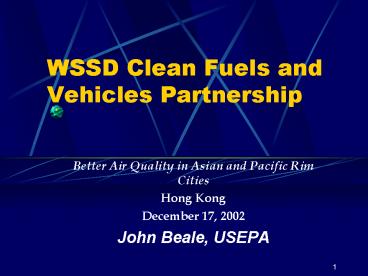WSSD Clean Fuels and Vehicles Partnership - PowerPoint PPT Presentation
1 / 20
Title:
WSSD Clean Fuels and Vehicles Partnership
Description:
International Organizations:, UNEP, Pan-American Health Organization (PAHO), WHO, ... bronchitis in children, 360,000 asthma attacks, and 1.5 million lost work days ... – PowerPoint PPT presentation
Number of Views:83
Avg rating:3.0/5.0
Title: WSSD Clean Fuels and Vehicles Partnership
1
WSSD Clean Fuels and Vehicles Partnership
- Better Air Quality in Asian and Pacific Rim
Cities - Hong Kong
- December 17, 2002
- John Beale, USEPA
2
Powering Sustainable Development
- U.S. WSSD Clean Energy Initiative
- Global Village Energy Partnership
- Energy Efficiency for Sustainable Development
- Healthy Homes and Communities
3
Healthy Homes and Communities
- Partnership for Clean Fuels and Vehicles
- Partnership for Clean Indoor Air
4
Partnership for Clean Indoor Air
- Brings together governments, non-governmental
organizations, and the private sector to focus
on - Reducing exposure in the developing world to
indoor pollution from home cooking and heating
practices - Increasing access to affordable, reliable, clean,
and efficient home cooking and heating techniques
5
What will the Partnership do?
- Obtain formal commitments from partners to
address - Social and cultural barriers to cleaner cooking
- Development of sustainable business models and
markets to support changes - Establish criteria to assess technologies for
more efficient cooking and heating approaches - Assess health impacts of improvements
6
Current Partners
- Governments Canada, Italy, Mexico, South Africa,
U.S., 7 Central American Countries - Non-governmental organizationsWinrock
International, Shell Foundation, UC/Berkeley
Renewable and Appropriate Energy Laboratory
- Industry LPG Association of Southern Africa
- International Organizations, UNEP, Pan-American
Health Organization (PAHO), WHO, World Bank,
United Nations Department of Economic and Social
Affairs
7
Clean Fuels and Vehicles Partnership
- Brings together governments, industry and
non-governmental organizations to focus on - The elimination of lead in gasoline
- The reduction of sulfur in diesel and gasoline,
while adopting cleaner vehicle technologies.
8
What will the Partnership do?
- Assist countries to develop and implement action
plans for the adoption of cleaner fuel standards
and cleaner vehicle requirements - Develop and disseminate data and information,
public outreach materials, educational programs,
as well as develop enforcement and compliance
programs and - Foster key partnerships between government,
industry, NGOs
9
Current Partners
- Governments Australia, Canada, Chile, China, 7
Central American countries, Italy, Mexico,
Netherlands, South Africa, US - Industry API, Alliance of Automobile
Manufacturers, MECA, BP, American Honda, AECA,
JAMA,AECC, AIAM, EMA, IFQC, International,
Lubrizol, Petrobras
- Non-governmental organizations NRDC, Alliance to
End Childhood Lead Poisoning, Global Environment
and Technology Foundation - International Organizations United Nations
Department of Economic and Social Affairs, UNEP,
and the Pan-American Health Organization (PAHO)
10
A renewed focus on lead
- Pb in gasoline
- is a potent neurotoxin and causes
- Lowered IQ scores, lifelong learning problems,
and aggressive behavior - precludes the use of catalytic converters to
reduce other hazardous vehicle pollutants (CO,
HC, NOx Toxics) - Much Progress In the last 6 years, more than 50
countries have taken action to eliminate lead in
gasoline. - Still more to doLead remains a continuing
problem in Africa, Indonesia, Peru, and a few
other countries
11
A New Commitment fo Reducing Sulfur
- New worldwide focus on reducing sulfur in diesel
and gasoline - Diesel emissions increasing in urban areas
- Sulfur fuel specs vary from near-zero to 10,000
ppm - Particulates from vehicles are sub-micron (PM
2.5) in size, especially damaging to public
health.
12
Sulfur and PM
- High sulfur levels in diesel and gasoline
contribute to ambient PM - Emitting particles directly
- Producing secondary particles in the urban
atmosphere - Preventing emission reduction technologies from
operating properly - Nox adds to the ambient particulate loading and
ozone - Reducing sulfur in fuel, even to intermediate
levels, can immediately impact emissions from
existing vehicles
13
Sulfur, PM and Health Effects
- Fine particulates from diesel emissions
contribute to respiratory problems, especially in
children - EPA has recently classified diesel emissions as a
likely human carcinogen - EPA has quantified the benefits of reducing
sulfur in diesel in the US - 110,000 tons of PM reduced each year
- Prevention of 8,300 premature deaths, 7,600 cases
of acute bronchitis in children, 360,000 asthma
attacks, and 1.5 million lost work days
14
Partnership Activities
- Work with countries to develop country-specific
plans - Provide technical assistance
- Refinery modeling, emission inventory
- Public outreach
- Legislative analysis
15
November 14 15Partnership Meeting
- UN Headquarters in New York
- Model WSSD Type 2 Partnership
- Outcomes
- Projects in specific regions
- Strategy for the Partnership
- Mechanisms for coordination.
16
Coordination of Partnership
- UNEP has offered to host coordinator at UNEP
Headquarters in Nairobi, Kenya - Several partners have contributed funding for
coordinator - Partnership will have a website and listserv for
communication
17
Next Steps
- 3 workgroups formed to develop simple and
consistent positions on - Valve Seat recession
- Octane requirements and replacements
- Sulfur in diesel and impact on PM
- Priority projects identified
18
EPAs Program
- Technical assistance for a variety of projects
- Africa Lead Phase-out
- India
- Mexico
- Peru
19
Fuels and Vehicles PartnershipSide Event in Hong
Kong
- Wednesday, December 18th
- Hong Kong Convention Center
- Agenda
- Organized by ADB and the Clean Air Initiative
- Presentations from Asian countries/industries
20
For More Information, contact
- Kathleen Abdalla
- UN Department of Economic and Social Affairs,
New York - abdallak_at_un.org
- Jane Metcalfe
- USEPA, Washington
- metcalfe.jane_at_epa.gov































